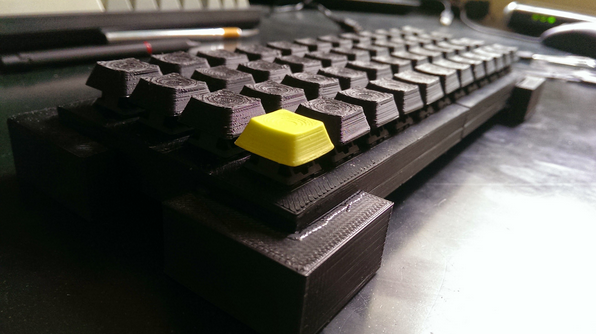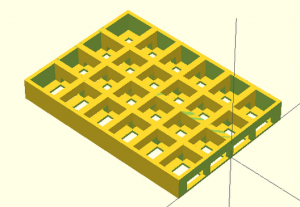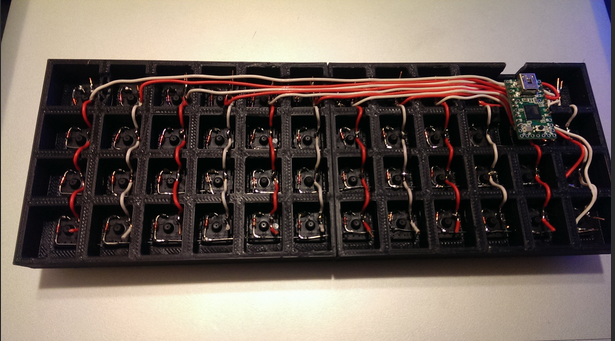 One day we will be able to 3D printed all sorts of already assembled electronics. That day may still be a decade away, but that doesn’t mean that we all can’t have a little fun right now. Equipped with a 3D printer, a little bit of technical know-how, and patience, anyone can assemble DIY gadgets that are almost entirely 3D printed.
One day we will be able to 3D printed all sorts of already assembled electronics. That day may still be a decade away, but that doesn’t mean that we all can’t have a little fun right now. Equipped with a 3D printer, a little bit of technical know-how, and patience, anyone can assemble DIY gadgets that are almost entirely 3D printed.
That’s just what one man named Adam Forland has done with his latest project to design, 3D print, and assemble a working Planck-inspired mechanical keyboard. Forland, who isn’t exactly an experienced keyboard designer, taught himself everything he needed to know for this project.
“I just got into Mechanical KBs a month ago but I was immediately drawn to the idea of a [DIY] keyboard. The plate, feet and key caps are all 3D printed on my desktop printer,” explained Forland. “I then hand wired it to a Teensy controller and programmed a few different custom layouts. The green/yellow keys are the arrow keys and a function key.”
 Forland’s keyboard doesn’t exactly look like an ordinary keyboard which most of us are used to typing on. Instead, all of its keys are shaped the same — meaning that there is no elongated space bar; a line of 5 keys at the bottom between the function and arrow keys can be used for spacing.
Forland’s keyboard doesn’t exactly look like an ordinary keyboard which most of us are used to typing on. Instead, all of its keys are shaped the same — meaning that there is no elongated space bar; a line of 5 keys at the bottom between the function and arrow keys can be used for spacing.
The design and printing process was not exactly quick and easy, but it was somewhat affordable. Forland relied on his Lulzbot Mini 3D printer and had to break the main case of the device up into two sections since his build platform was not large enough. Using a 0.5mm nozzle, he printed the board at a 0.3mm layer height and the actual keys at a 0.18mm layer height using ABS thermoplastic. He then purchased several components which included a Teensy 2.0 USB development board for $16, 48 Cherry MX green switches for $30, more than enough wiring for $6, and he estimates he used about $5 in ABS filament.
“Time commitment was the real cost. Each part needed to be cleaned so that it fit with precision,” Forland explained.
When all was said and done, the keyboard measured approximately 9 x 25 x 3 cm in size and, according to Forland, it works like a charm. Although projects such as this may not be the most economical from either a financial or a time perspective, they certainly are a great way to lean how particular every day gadgets and gizmos function.
For those interested in printing and assembling this keyboard, Forland has made the design files available for free on Thingiverse. The 3D printable Cherry MX key caps an be found at a second location on the Thingiverse website, here. In addition, details on wiring a typical keyboard can be found here.
Let us know if you have tried your hand at this project. Feel free to post your experiences and feedback in the 3D printed keyboard forum thread on 3DPB.com.
Subscribe to Our Email Newsletter
Stay up-to-date on all the latest news from the 3D printing industry and receive information and offers from third party vendors.
You May Also Like
Precision at the Microscale: UK Researchers Advance Medical Devices with BMF’s 3D Printing Tech
University of Nottingham researchers are using Boston Micro Fabrication‘s (BMF) 3D printing technology to develop medical devices that improve compatibility with human tissue. Funded by a UK grant, this project...
3D Printing Webinar and Event Roundup: April 21, 2024
It’s another busy week of webinars and events, starting with Hannover Messe in Germany and continuing with Metalcasting Congress, Chinaplas, TechBlick’s Innovation Festival, and more. Stratasys continues its advanced training...
3D Printing Webinar and Event Roundup: March 17, 2024
It’s another busy week of webinars and events, including SALMED 2024 and AM Forum in Berlin. Stratasys continues its in-person training and is offering two webinars, ASTM is holding a...
3D Printed Micro Antenna is 15% Smaller and 6X Lighter
Horizon Microtechnologies has achieved success in creating a high-frequency D-Band horn antenna through micro 3D printing. However, this achievement did not rely solely on 3D printing; it involved a combination...































